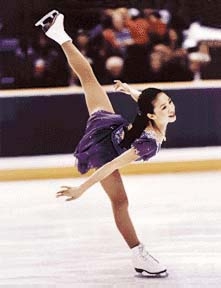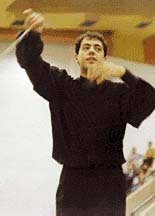
Winter 1996 (4.4)


The orchestral works of Azerbaijani
composer Fikrat
Amirov are often heard in Baku's ornate Ballet and Opera
Theater, the Philharmonia, and the Republic Palace. But lately,
Amirov's music has found a new venue and is being discovered
by an entirely new audience. Sixteen-year-old Michelle Kwan,
a Chinese-American from Los Angeles and winner of the 1996 World
Championship Figure Skating Competition, is skating to Amirov's
music in competitions all season as she prepares for
the 1997 World Championships to be held this March in Lausanne,
Switzerland.
We found Michelle's choreographer,
Lori Nichol, in Toronto, Canada, and asked how she had chanced
upon this composer who is highly esteemed in Azerbaijan, but
is known so little beyond the borders of the former Soviet Union.

 When
Lori Nichol first happened upon Amirov's "Gulistan Bayati
Shiraz" this past January, she knew it was a winner. "It
blew me away!" she confesses. "It was so passionate,
majestic and intriguing. It had all the characteristics we had
been looking for. It's such a deep and complicated piece of music.
When
Lori Nichol first happened upon Amirov's "Gulistan Bayati
Shiraz" this past January, she knew it was a winner. "It
blew me away!" she confesses. "It was so passionate,
majestic and intriguing. It had all the characteristics we had
been looking for. It's such a deep and complicated piece of music.
Photo: The Taj Mahal inspired Michelle Kwan's latest choreography.
Courtesy: Archives of the Consulate of India, Los Angeles.
"Very few orchestral pieces
are left that play well in a huge arena filled with 20,000 fans,"
observes Nichol. "You need something dramatic and full of
energy that commands attention and yet fulfills all the other
requirements of the program, as well. We thought the Amirov piece
could do it."
It's no exaggeration that Nichol
listened to hundreds and hundreds of symphonic pieces this past
year before coming across Amirov's "Gulistan."
Nichol, who has created hundreds of programs, is always in search
of new music, convinced that fresh ideas and fresh interpretations
give the skater an "edge" in competition. That's why
she devotes nearly the entire year to listening to symphonic
music to find the pieces she thinks will choreograph best.
"I have a strong memory
for steps that I've choreographed in the past. When I hear a
piece of music that I've worked with before, it's very hard for
me to mentally erase the original movements that I've come to
associate with it. That's why I like the challenge of identifying
new music."
Michelle's coach, Frank Carroll,
judges music in terms of whether or not it is memorable. "When
the event is over, I want people to go home humming the melody
or, at least, having it play over and over in their minds."
No doubt, he's counting on the subconscious power of the music
to influence the judges over the duration of the season. Carroll
should know what works. From his training camp at Lake Arrowhead
in the San Bernadino Mountains east of Los Angeles, he has trained
numerous skaters who have gone on to become national and international
champions.
But there's more to choosing
music for the ice than mere personal preference. Rules of competition
place severe restrictions on the selection process. For starters,
vocal music with lyrics or words is not allowed. A new rule,
however, passed in June 1996, permits music that uses voices
as instruments. It was a lucky break for Nichol as she wanted
to choreograph Amirov's ballet, "The Arabian Nights,"
for another young skater, Jere Michael, who is trying to qualify
for the U.S. National Championships. Nichol found the music to
be "absolutely gorgeous," and was so glad the rules
had been changed so that she could develop it.
But the greatest restrictions
have to do with the duration of the piece. Competitive skaters
perform two programs. The Short Program cannot exceed two minutes
and 40 seconds. Eight separate elements-spins, spirals, footwork
and double- and triple-rotation jumps-must be performed in that
brief time. The Free Program can extend to four minutes and 10
seconds for women. This program gives skaters a chance to highlight
the movements they do best. Michelle does seven triple-rotation
jumps, two double axles, as well as spins, steps, and freestyle
moves that she thinks best exhibit her artistry and flexibility.
The Free Program counts for two-thirds of the total points of
the combined performances.
According to Nichol, the music
has to build at precisely the right moments-both in terms of
tempo and crescendo. But that doesn't mean that a piece will
work well if it's all "vivace" or "presto."
Typically, music is chosen which has a change in tempo or, at
least, a pause to give the skater a chance to catch her breath.
And a piece must always resolve itself in a climax within the
given time frame.
With all these requirements,
it's no wonder that skaters settle for pieces that have been
used over and over again, such as "Romeo and Juliet"
by either Tchaikovsky or Prokofiev, "William Tell Overture"
by Rossini, Hungarian Dances by Bartok, "West Side Story"
by Bernstein or other pieces by Rachmaninoff or Chopin.
Finding Music

 Each autumn, it's
"music-buying time," when Nichol straps her two-year-old
son, Austin, into the back seat of her car for the hour's drive
to Toronto where she can shop at the major music stores. It's
typical for her to buy anywhere from $400-$500 worth of CDs on
a single trip. Fortunately, she's discovered the HMV chain of
stores which offers a return policy. "We used to spend thousands
of dollars and sometimes end up with nothing for all our time,
effort, and money. But now we can sample the music of many composers
that we would never have dared to purchase otherwise," Nichol
notes appreciatively.
Each autumn, it's
"music-buying time," when Nichol straps her two-year-old
son, Austin, into the back seat of her car for the hour's drive
to Toronto where she can shop at the major music stores. It's
typical for her to buy anywhere from $400-$500 worth of CDs on
a single trip. Fortunately, she's discovered the HMV chain of
stores which offers a return policy. "We used to spend thousands
of dollars and sometimes end up with nothing for all our time,
effort, and money. But now we can sample the music of many composers
that we would never have dared to purchase otherwise," Nichol
notes appreciatively.
Photo: Lori Nichol and her son Austin of Canada. Nichol
discovered the Amirov music and choreographed Michelle Kwan's
Figure Skating Program.
After making her selections,
she places up to six CDs into the built-in CD player in her car,
and listens all the way back home to Keswick. She quickly scans
past the material she know won't work. "I'm probably a hazard
on the freeway, with a baby in the back seat and me, listening
so intensely to music. I've missed my exit more than once,"
she confesses.
Soon after Nichol found the Amirov piece, Michelle flew to Toronto,
and the two tried the music out on the ice. "Sometimes,
you hear a piece in the comfort of your studio and it sounds
wonderful, but then when you try to skate to it, it simply doesn't
work," says an experienced Nichol, who won second place
in the 1983 Professional World Championships. But Michelle loved
the Amirov piece immediately and found it exotic and mysterious.
The next task was to begin the
long and arduous task of editing. The "Gulistan"
piece at 16 minutes in length was considered quite long
to edit down to a mere four minutes. Nichol found herself listening
to the entire production over and over again. "It's a tough
job when you're trying to stay true to the composer's original
intentions. Our goal is to maintain the essence of the piece
and truly reflect the spirit of the composer, while at the same
time support the technical aspects of skating as well."

 Editing
needs to take into account the best way to maximize the energy
of the skater. Obviously, in the early minutes of the piece,
the skater is fresher, so the music can be faster and more intense.
But soon the skater needs a break from this fast tempo. Since
the "Gulistan" piece really didn't have any slow parts
that worked, they had to introduce a short section by the French
composer Maurice Jarre. "It's tremendously difficult to
perform artistically when the technical demands are so high.
You have to do what makes the skater look best and what will
not adversely affect the elements," observes Nichol.
Editing
needs to take into account the best way to maximize the energy
of the skater. Obviously, in the early minutes of the piece,
the skater is fresher, so the music can be faster and more intense.
But soon the skater needs a break from this fast tempo. Since
the "Gulistan" piece really didn't have any slow parts
that worked, they had to introduce a short section by the French
composer Maurice Jarre. "It's tremendously difficult to
perform artistically when the technical demands are so high.
You have to do what makes the skater look best and what will
not adversely affect the elements," observes Nichol.
Editing was a tedious job that
took weeks. "We must have edited about 20 different versions
from beginning to end before we were satisfied." After that,
Nichol and Kwan began to choreograph.
Photo: Yalchin
Adigezalov, Director
of Azerbaijan's State Symphony Orchestra, who conducted Fikret
Amirov's music.
Amirov's piece is defined as a "symphonic mugam" (pronounced
moo-GAM) in the spirit of traditional Azerbaijani music. "We
had a lot of difficulty trying to figure out what 'mugam' meant.
We took it to a music professor, we called friends, and we asked
people with music degrees, but no one could give us a meaningful
answer. In the end, we followed our own intuition. We felt that
simply enjoying the energy and passion of Amirov's piece was
more important than being able to describe it theoretically."
Next, because the music had
such depth, they felt they should develop a story line. "It
just seemed to be saying something to us, so we took artistic
license and created a love story," Nichol says, reflecting
on the creative process.
It turns out that her intuition
was right. "Gulistan" means "place of flowers
or flower garden," and "Bayati
Shiraz" is the name of one of the classical modes
of mugam which is very popular in Azerbaijan. This specific mode
is made up of musical intervals that are believed to inspire
feelings of well-being, passion and love.
The CD liner notes indicate
that Amirov had been influenced in his composition by the poetry
of the Persian writers Hafiz (13th century) and Saadi (16th century).
Unfortunately, no mention is made of the specific poems.
The Taj Mahal Story
Line
Listening to it for the zillionth
time, Frank finally said, "Well, what about the Taj Mahal?"
Could they choreograph the piece to personify the splendor of
this beautiful architectural monument? But the Taj Mahal is in
India, not Azerbaijan. They wondered if they should dare such
a combination.
"We both love the Taj Mahal
even though we've never been there," says Nichol. So she
headed to the library in search of more information. She discovered
that the monument was completed in 1643 after 22 years of construction.
The council of architects involved was quite cosmopolitan for
its day, including experts from India, Persia and Central Asia.
Shah Jahan had dedicated the Taj Mahal to the memory of his wife,
Arjumand Banu Begam, who had died in childbirth. She was often
called "Mumtaj Mahal," which translates as "Chosen
One of the Palace."
Finally after much searching,
Nichol found a quote describing the memorial: "Both inside
and out, the marble reflects the light and mood of the changing
day. Dazzling at noon. Warm and glowing at dusk. Soft and ethereal
in the moonlight like the varying moods of a beautiful woman."
And based upon that description,
Nichol and Carroll created the choreography-the imagery of the
sun as it shines against the white marble of the building casting
various shadows and creating different moods. The artistic movement
climaxes in the evening when the story reveals the spirit of
Mumtaj rising out of the crypt, searching through the halls of
the mausoleum for her husband and then dancing with him. Then,
just before the sun rises for a new day, she disappears in despair
back into her grave.
According to Nichol, so many
details have gone into choreographing this piece, even down to
the smallest rippling movements of the body and facial expressions.
The performance is filled with such subtleties.
"Part of what I'm trying
to do in the choreography is to touch the hearts and imagination
of people," Nichol confides. "That's what Michelle
is trying to do, too. We're trying to give a gift to the people
who are watching. And if, in the process, we're able to attract
attention and focus upon a culture such as Azerbaijan's that
is relatively unknown, because of our choice of music, well,
then, that's an added bonus!"
"But I hope we haven't
offended Azerbaijanis by having chosen a story line based on
the Taj Mahal. It all somehow felt so relevant-the majestic,
rich music personifying such an extraordinarily beautiful monument."
According to Nichol, Amirov's
"Gulistan" is extremely powerful music and, therefore,
requires an extremely adept and powerful skater like Michelle
to perform it. "The music is so strong that if the skater
isn't exceptional, it would make her look weak."
"The performance is over
so quickly," she observes. "I don't think people can
really comprehend the complexity and difficulty of Michelle's
performance-perhaps not even some of the judges. I think you
would have to get a video of her performance and play it over
and over again, slowly, to really comprehend the level of difficulty
at which she is performing. She's really phenomenal!"
Michelle is busy now perfecting
the Amirov piece, which she will perform in at least three more
competitions, culminating in the World Championships which are
being held in Lausanne, Switzerland, March 17-23, 1997. So far
she has won first place in all three competitions in which she
has participated. Still to go are the Ultimate Four on December
22, the U.S. National Championships from February 10-16 (televised)
and the Champions Series Finals from February 27-March 1 (televised).

Current information about
Michelle Kwan is available at Web site<http://turnpike.net/~adweb
/kwan/index.html>.
Fikrat Amirov's "Gulistan Bayati Shiraz" is
available as a CD on the Olympia Explorer Series Label, OCD 490.
The performance was conducted by Azerbaijani Yalchin Adigezalov with
the Moscow Radio & TV Symphony Orchestra in Moscow in 1993.
Home | About
Azeri | Learn
Azeri | Arabic
Script | Store | Contact
us
Articles from Azerbaijan
International
© Azerbaijan International. Copyright 2002. All rights reserved.
|
|